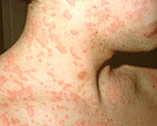


Urticaria (Hives) Overview
 Urticaria (or hives) is a kind of skin rash notable for dark red, raised, itchy bumps. It is frequently caused by allergic reactions; however, there are many non-allergic causes. Hives look somewhat like mosquito bites.
Urticaria (or hives) is a kind of skin rash notable for dark red, raised, itchy bumps. It is frequently caused by allergic reactions; however, there are many non-allergic causes. Hives look somewhat like mosquito bites.Hives can range in size from a few millimeters to several inches in diameter. Hives can be round, or they can form rings or large patches. Wheals (welts), red lesions with a red "flare" at the borders, are another manifestation of hives. Hives can occur anywhere on the body, such as the trunk, arms, and legs.
One of the cardinal features of hives is its tendency to change size and disappearing in one place and reappearing in other. An outbreak, which may look alarming in the morning, may not be there at all by the evening, to reappear again later. In most cases by the time the patient reaches the doctor there is nothing to show to him. But usually the diagnosis can be made on the history as rarely any other skin disease has such quick outbreaks and remissions.
What are the causes of Urticaria?
Top
Acute Urticaria (Hives) is frequently caused by allergic reactions. But chronic Urticaria (more than 6 weeks) in most cases has Idiopathic (unknown) causes.
The Common triggers for Urticaria are:
- Allergies to food, medications, cosmetics, soaps, and detergents
- Insect stings and bites
- Emotional and physical stress
- Physical agents such as sunlight, heat, cold, water, or pressure
- Allergies to pet dander
- Dampness
- Change of weather
- Transfusions of blood or blood products
- Exercise
- Infections such as viral illnesses, especially in children
What are the sign and symptoms of Urticaria?
Top
The cardinal symptom is the Rash; smooth, raised, pink or reddish bumps of different sizes it can look somewhat similar to mosquito bites.
Itching which can be severe
The hives usually first appear on covered area of the skin like arms and trunks then usually spreading to the whole body.
Hives have a tendency to change size and disappearing in one place and reappearing in other. An outbreak, which may look alarming in the morning, may not be there at all by the evening, to reappear again later. In most cases by the time the patient reaches the doctor there is nothing to show to him. In severe cases the hives may affect the eyes causing swelling
The hives usually first appear on covered area of the skin like arms and trunks then usually spreading to the whole body.
Hives have a tendency to change size and disappearing in one place and reappearing in other. An outbreak, which may look alarming in the morning, may not be there at all by the evening, to reappear again later. In most cases by the time the patient reaches the doctor there is nothing to show to him. In severe cases the hives may affect the eyes causing swelling
How is Urticaria Diagnosed?
Top
The diagnosis is usually based on history and physical examination. The doctor usually tries to figure out the trigger factors hives.
In some cases specialized allergic test might be done.
What is the role of Homoeopathy in Urticaria?
Top
Related information will be available very soon sorry for inconvinience

Urticaria




